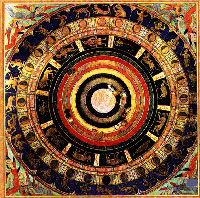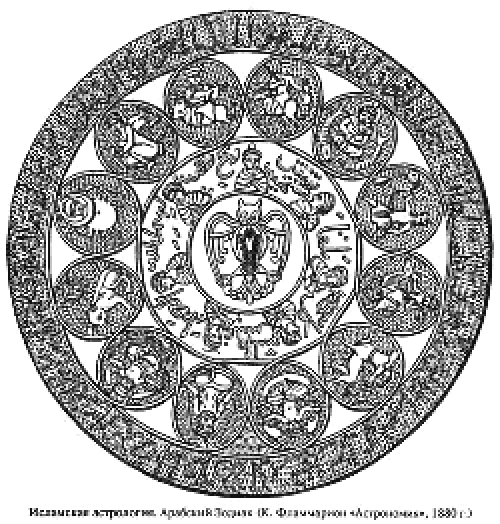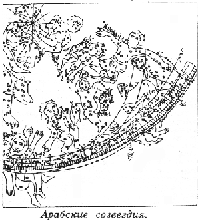

Astrology and Islam
 adheres to the concept of divine predetermination, and astrological predictions were perceived as confirmation of this concept. Besides, astrology was inseparably linked with astronomy, and the calendar system of religious holidays and abstinences, definition of time of prayers and the sacred direction to Mecca (a so-called Qibla) - all this became by means of astronomical observations and calculations. Therefore in the Islamic world astrology reached unprecedented blossoming. Almost only concession which Muslim astrologers had to make was change of drawings of zodiac signs. Not to break the ban on the image of the person, astrologers of the Muslim world replaced the sign of Twins with two peacocks, the Maiden - wheat sheaf, and Aquarius - the donkey carrying on himself two baskets. Astrology played an important role in theoretical creation of various currents of Moslem. In particular, the most prominent Sufi thinkers included astrological compliances in the mystical views on space as the uniform beginning of life. The Shiite sect of batinit developed the doctrine about an emanation and about overlapping of a macrocosm and microcosm, connecting it with the religiouspolitical theory of the imamat (reflection of world mind in the lower world is the perfect person - the prophet, world soul - the imam). There were also ideas of symbolical compliance of seven prophets of Islam to seven planets (in their astrological understanding).
adheres to the concept of divine predetermination, and astrological predictions were perceived as confirmation of this concept. Besides, astrology was inseparably linked with astronomy, and the calendar system of religious holidays and abstinences, definition of time of prayers and the sacred direction to Mecca (a so-called Qibla) - all this became by means of astronomical observations and calculations. Therefore in the Islamic world astrology reached unprecedented blossoming. Almost only concession which Muslim astrologers had to make was change of drawings of zodiac signs. Not to break the ban on the image of the person, astrologers of the Muslim world replaced the sign of Twins with two peacocks, the Maiden - wheat sheaf, and Aquarius - the donkey carrying on himself two baskets. Astrology played an important role in theoretical creation of various currents of Moslem. In particular, the most prominent Sufi thinkers included astrological compliances in the mystical views on space as the uniform beginning of life. The Shiite sect of batinit developed the doctrine about an emanation and about overlapping of a macrocosm and microcosm, connecting it with the religiouspolitical theory of the imamat (reflection of world mind in the lower world is the perfect person - the prophet, world soul - the imam). There were also ideas of symbolical compliance of seven prophets of Islam to seven planets (in their astrological understanding).There was a legend that the Muslim prophet Idris was the first astrologer. There were even astrological interpretation of some verses of the Koran (just as in Christianity there were astrological interpretation of the Bible), and prophets of Islam were compared with planets.
Compliance of planets to prophets in Islam:
| Saturn | Ibrahim (Abraham) |
| Jupiter | Musa (Moses) |
| Mars | Harun (Aaron) |
| Venus | Yusuf (Joseph) |
| Mercury | Isa (Jesus) |
| Sun | Idris (Enoch) |
| Moon | Adam |
According to a Koranic cosmogony, Allah is thought of the creator of the Universe consisting of lower - terrestrial and top - heavenly worlds. He divided the sky and the earth, made of water "any thing live" (21:31), in two days he created the earth and seven heaven, having decorated the next sky "with lamps and for protection" (41:8,10,11). Allah created "seven heaven ranks" (67:3, 71:14), i.e. one over another, "and made Moon on them light, and made the Sun the lamp" (71:15). Over the seventh sky Allah's throne is located. In heaven paradise (Gianna) and hell (Jahannam) are located, and they do not occupy all space of heaven. Paradise, according to many legends, is in the seventh heaven; hell, according to one of versions, - below the first sky. Inhabitants of heaven are the angels (malāk, fereshteh) created from light and transferring to people of a message from Allah (15:8). Access to the sky is reliably protected from evil spirits by angels and stars, "the striking torches" (37:6-10).
Islamic astrologers did not seek to reason the astrological doctrines as it was during a Hellenism era. As well as in medieval Europe, proofs were not obligatory since influence of stars on the sublunary world was the self-evident fact.
doctrines as it was during a Hellenism era. As well as in medieval Europe, proofs were not obligatory since influence of stars on the sublunary world was the self-evident fact.
Astrology got into Islamic cultural circles from 8th century. Scientific (including astrological) knowledge of Arabs was eclectic as they came from various sources belonging to different cultures. It is considered that in Islamic astrology three main astrological currents mixed up: Hellenistic, Indian and Sassanian astrologies. The big contribution to science was made group of the Jewish scientists who prospered at initially tolerant Arab Caliphs. The highest achievements in sciences followed establishment of a dynasty of Abbasids in 750. Abassidic Caliph Al-Mansur transferred the capital from Damascus to the new city of Baghdad. It was founded on the west bank of the Tiger in 762 at the optimum moment determined by court astrologers of
Naubakht
and Mashallah ibn Athari, and then constructed on geomantic principles. At the beginning of the 9th century Baghdad, probably, became the largest city of the world: in it there lived about one million people.
The first astrological school in Baghdad was founded in 777 by the Jewish scientist Jacob bin Tariq. This school became known thanks to the scientific treatises and the translations made by her members.
Abu Maʿshar (perhaps, the best-known of all Arab astrologers) was the head of this school in the middle of the 9th century. He translated
Ptolemaeus
into Arabic, and these its translations then were in turn translated into Latin by European scientists. Abu Maʿshars teacher
Al-Kindi
in the same years translated into Arab more than 200 treatises among which - a set of the abstract researches concerning influence of stars. In general, at the disposal of the Arab scientists there were works in many languages: they translated from the Greek and Syrian languages treatises by astrologers of the Hellenistic period, from Sanskrit - the Indian versions, from Pehlevi - the conglomerate of two above-named astrological currents which arose during Sasanian era. Thus, the Arab scientists had a unique opportunity to be at the first boundaries of knowledge. Many of these works got into Europe through the Arab Spain subsequently. Cordoba which had the population about half a million people was one of the largest centers of knowledge. To it students from other European countries were flown down to learn from the Arab teachers. One of such students, Gilbert d'Auvergne, became a Pope Sylvester II subsequently.
The value that astrology has on the way of thinking, the political and cultural life of Muslims, it is difficult to overestimate.
The certificate of it is a large number of considerable Islamic astrologers. Science about stars (eulim alnujum, eulim altanjim; these two terms designated both astronomy, and astrology) was the most popular natural science in the Middle Ages.
"Introductions..." and zījes became the most popular genres of astrological literature in the Islamic countries.
"Introduction to Judic Astrology" - sinaʻa akhkam an-nudzhum ("art of sentences of stars") - contained key data on drawing up and interpretation of horoscopes. Modern historians know 116 medieval Muslim authors who wrote "Introductions to astrology"; besides, our time was reached by some more tens of similar compositions which authorship is not established. The most important works of this type are "The book about sciences about stars" Abu Maʿshar, "Introductions to art of sentences of stars" of
Al-Qabisi
and Kūshyār Gīlānī, "Book of Instruction in the Elements of the Art of Astrology"
Al-Biruni.
Zījes were the main "technical literature" of astrologers. They represented the astronomical tables giving the chance to define provisions of planets on the heavenly sphere. These tables were formed on the observations made in large astronomical observatories of the Arab world. In many zījes a final part represented the guide to interpretation of horoscopes. Total number known zījes is several hundreds.
Even in the people astrology was very popular. So, for example, in the book "One Thousand and One Nights" the slave of Tawaddud ("The story about Tawaddud", nights 436-462) explains properties of seven planets, value of lunar houses, the main properties of zodiac signs, tells about compliance of lunar houses to zodiac signs, days of the week - to planets and reports a lot more other astrological data. It is necessary to notice that the story about Tawaddud was a peculiar short encyclopedia of data which each educated Muslim has to possess.
All of you remember how Nasreddin Hodja tortured the court astrologer by means of "a rope and a stick".

In the Islamic world where the idea of the highest predetermination dominated, were especially esteemed
elective and
horary astrology, exercises about aspects, lots, fixed stars and cycles of planets developed, special significance was attached to political astrology. Need of further development of mathematical and astronomical bases of astrology was connected with this activity. After the 9th century Islamic astrology inclines to drawing up compilations, the short guides and pocket reference books more and more. Eventually in Islamic astrology tendencies to association of a goroskopiya with magic appeared.
According to Al-Farabi, astrology contains 8 sections:
-
creation of horoscopes;
-
studying of physical laws;
-
astrological influences on agriculture;
-
astrological influences on navigation;
-
astrological alchemy;
-
the doctrine about gemstones and mascots;
-
theory of mirrors and laws of optics.
This list well illustrates areas which were developed by the Arab astrologers.
It should be noted that the most prominent Sufi thinkers (in particular, Ibn ʿArabi and Al-Ghazali) included astrological compliances in the mystical views on space as the uniform beginning of life. The original astrological doctrine was developed by Shiite sect of Batiniyya.
Up to our days astrology plays an important role in life of the countries of Islam. Achievements of Islamic astrology had significant effect on development of the European astrology during an era of the late Middle Ages and the Renaissance. Europe got acquainted with Muslim astrology thanks to the numerous translations which were generally becoming in the XI-XII centuries in Spain (among most known "transmitters" of the Arab wisdom there is John of Seville, Adelard of Bath, Gerard of Cremona, Plato Tiburtinus, Hugo of Santalla, Roger of Hereford, Michael Scot, Arnaldus de Villa Nova). Besides, through the Arab scientists Europe studied compositions of many antique authors (including Platon, Aristotle, Ptolemaeus). Unfortunately, we cannot estimate in a due measure a contribution of Islamic scientists to development of astrology until numerous manuscripts on Arab, Persian and Turkish languages are translated. Till today these treatises are stored unclaimed in museum collections in different regions of the world. It is sad to understand that even works of stars of the Arab astrology, not to mention less large astrologers are not transferred.
Main terms of the Arab astrology:
-
Zodiac signs (alburuj - "castles"): Aries - alhamal, Taurus - althawr, Twins - aljuza', Cancer - sartan, Lion - al'asad, Maiden - aleudhra', Scales - almizan, Scorpion - aleaqarab, Sagittarius - alqaws, Capricorn - aljidiyu, Aquarius - aldulu, Fishes - alhut.
-
"two bright stars": Sun (Shams) and Moon (Quamar).
-
alkawakib - "the wandering stars": Mercury (Otaared), Venus (Zuhra), Mars (Merrikh), Jupiter (Mushtari), Saturn (Zuhal).
-
Ecliptic - alfalakiat alburuj ("a zodiac circle").
-
Horoscope - tasaeudi ("ascending").
-
Horoscope corners - 'awtad alkhayima ("pegs").
-
Houses of a horoscope - abraj albayt.
-
Afesis - tasrih.
Literature
 Карманный словарь атеиста / Ю.А.Бахныкин, М.С.Беленький и др.; Под ред.
М.П.Новикова./ - М.: Политиздат, 1986
Карманный словарь атеиста / Ю.А.Бахныкин, М.С.Беленький и др.; Под ред.
М.П.Новикова./ - М.: Политиздат, 1986 Д.Куталев Новая астрологическая энциклопедия
Д.Куталев Новая астрологическая энциклопедия Астрологический словарь / Авт.-сост. С.Ю.Головин. - Мн.: Харвест, 1998
Астрологический словарь / Авт.-сост. С.Ю.Головин. - Мн.: Харвест, 1998 Джалялов Г. Отличие "Зидж Гурагони" от других подобных зиджей.//
Историко-астрономические исследования. Вып. I
Джалялов Г. Отличие "Зидж Гурагони" от других подобных зиджей.//
Историко-астрономические исследования. Вып. I Саплин А. Астрологический энциклопедический словарь
Саплин А. Астрологический энциклопедический словарь Объе К. Астрологический словарь.
Объе К. Астрологический словарь. Becker U. Lexicon der Astrologie
Becker U. Lexicon der Astrologie Бондаренко Ю. Астрология как социально-исторический феномен
Бондаренко Ю. Астрология как социально-исторический феномен Dictionnaire de l'astrologie./ Comp. Jean-Louis Brau
Dictionnaire de l'astrologie./ Comp. Jean-Louis Brau Грязневич П., Басилов В. Мусульманская мифология.// Мифы народов мира
Грязневич П., Басилов В. Мусульманская мифология.// Мифы народов мира Baigent M., Campion N., Harvey C. Mundane Astrology
Baigent M., Campion N., Harvey C. Mundane Astrology Матвиевская Г., Розенфельд Б. Математики и астрономы мусульманского
средневековья и их труды (VIII-XVII вв.)
Матвиевская Г., Розенфельд Б. Математики и астрономы мусульманского
средневековья и их труды (VIII-XVII вв.)Websites
 http://www.sunhome.ru/religion/11254
http://www.sunhome.ru/religion/11254  http://www.salam-alejkum.narod.ru/answers_horoscope.html
http://www.salam-alejkum.narod.ru/answers_horoscope.html